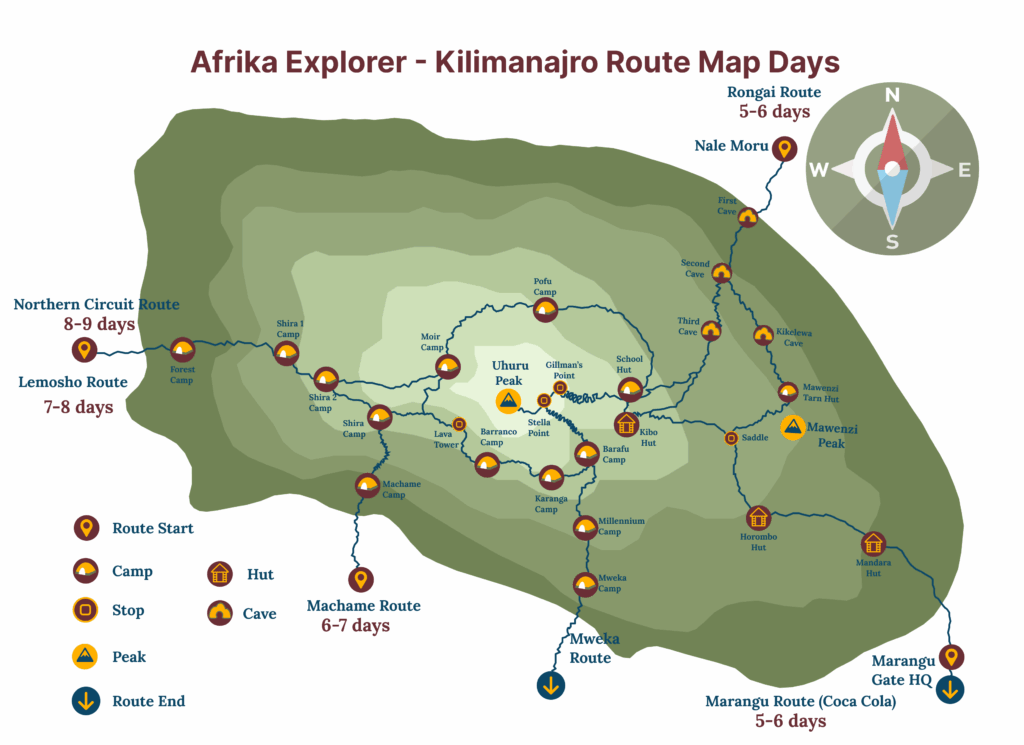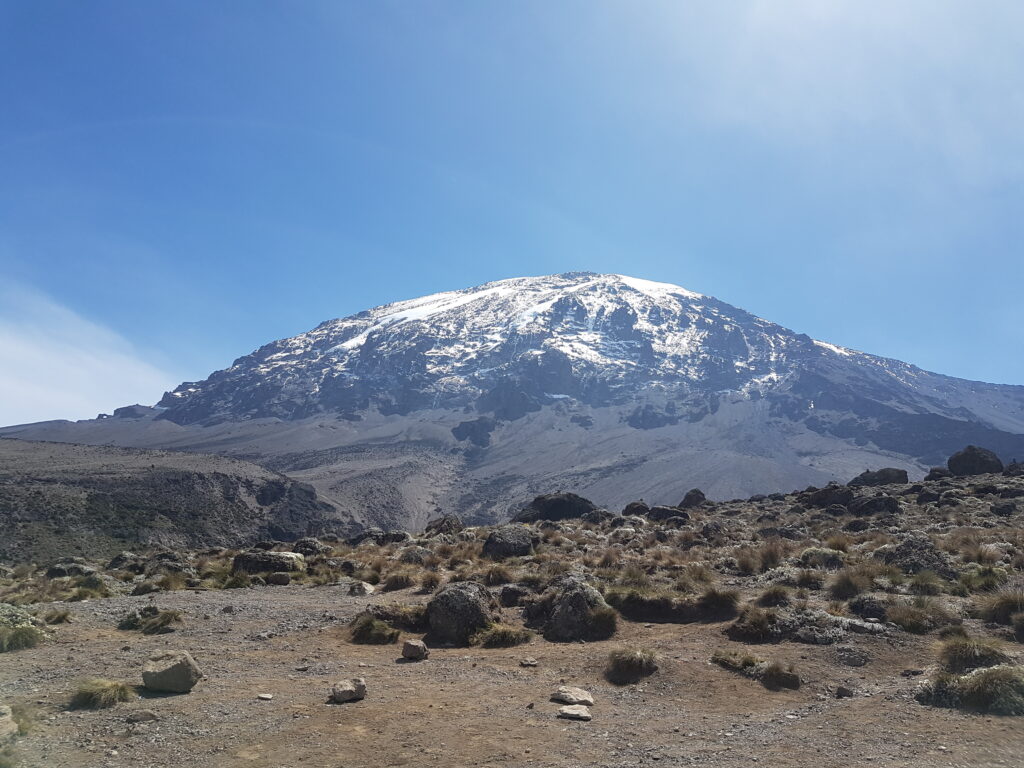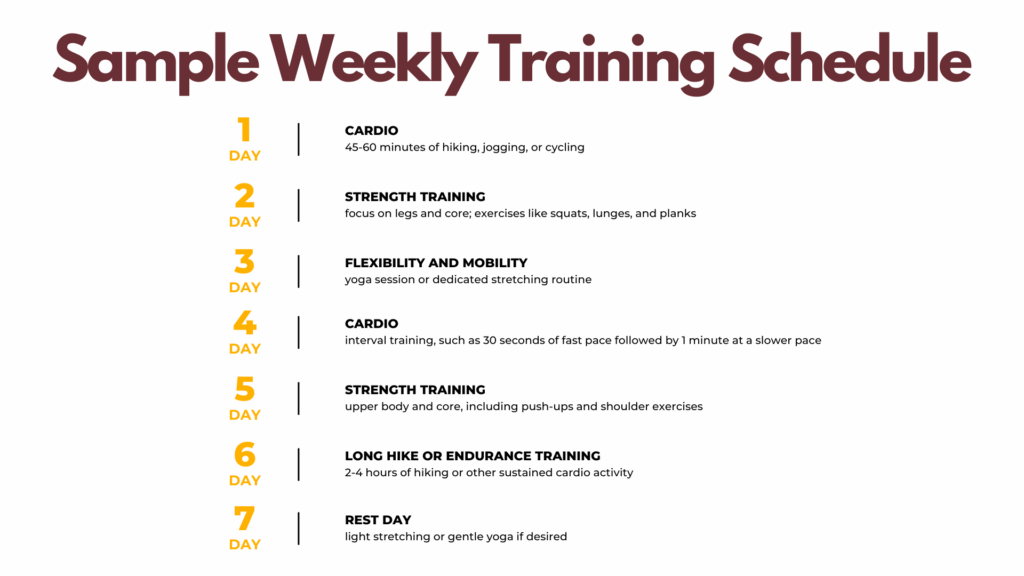“Pole pole,” say the locals—Swahili for “slowly, slowly.” And if you’ve ever dreamed of summiting Africa’s highest peak, that phrase will become your mantra.
Mount Kilimanjaro isn’t just a mountain, is a dormant volcano rising 5,895 meters (19,341 feet) above sea level, isn’t just a bucket-list destination—it’s a life-changing adventure!
But here’s a question that probably brought you here: how long does it really take to climb this iconic peak? The short answer is: it depends.
The long answer? Well, stick with me, and I’ll guide you through everything you need to know about planning your trek, from route options to preparation tips.
Did you know that success rates for reaching Kilimanjaro’s summit increase by nearly 50% if you choose a longer itinerary?
That’s right, the length of your climb can make or break your journey.
Whether you’re an avid hiker or a first-time trekker, understanding the intricacies of Kilimanjaro’s routes, acclimatization needs, and timing can be the difference between reaching Uhuru Peak and turning back too soon.
- Understanding Mount Kilimanjaro’s Climbing Duration
- Detailed Breakdown of Kilimanjaro Routes and Their Durations
- Factors Influencing Climb Duration
- Recommended Climb Durations for Optimal Success
- Physical and Mental Preparation for the Climb
- Cost Implications Based on Climb Duration
- Best Times of the Year to Climb Kilimanjaro
- Safety Considerations and Health Precautions
- Daily Itinerary: What to Expect Each Day on the Mountain
- Too Wrap Up
- FAQ: About How Long It Takes To Climb Kilimanjaro
Understanding Mount Kilimanjaro’s Climbing Duration
Climbing Kilimanjaro isn’t like checking off a quick weekend hike. It’s a full-scale expedition—one that usually takes between 5 and 9 days depending on the route, your fitness, and how well you adapt to altitude.
With seven official trekking routes, each offering its own unique challenges and rewards, the question of “So how long is enough?” often depends on your choice of path.
For most, the sweet spot is 7 or 8 days. That gives your body time to gradually acclimatize while still keeping the momentum and excitement of the trek alive. But again, it’s not just about days—it’s about how you use them.
Routes like Marangu, Machame, and Lemosho are crowd favorites, but each caters to different fitness levels and goals.
For example, the Marangu Route, also known as the “Coca-Cola” route, is often marketed as the easiest, but it’s also the most crowded.
The Machame Route, or “Whiskey” trail, boasts stunning scenery but demands more effort.
Then there’s the Lemosho Route, which offers a longer, more gradual climb that helps with acclimatization. We’ll explore these routes in detail to help you find the perfect fit.
By choosing wisely, you’ll not only optimize your time on the mountain but also set yourself up for a more enjoyable experience.
After all, climbing Kilimanjaro is as much about the journey as it is about the destination.
Detailed Breakdown of Kilimanjaro Routes and Their Durations
Not all routes are created equal. Each of Kilimanjaro’s seven established trekking routes has its own flavor—some are longer, more scenic, or less crowded; others are faster but tougher on your lungs. Let’s break them down.
| Route Name | Days Required | Difficulty | Success Rate | Scenery | Comments |
| Marangu | 5–6 | Moderate | 50% | Average | Only route with huts |
| Machame | 6–7 | Challenging | 65% | Excellent | Popular, beautiful, steep |
| Lemosho | 7–8 | Moderate | 85% | Stunning | Great acclimatization profile |
| Rongai | 6–7 | Moderate | 70% | Remote, scenic | Drier, approaches from the north |
| Northern Circuit | 8–9 | Long | 90% | Superb | Best for acclimatization |
| Umbwe | 5–6 | Very Hard | 50% | Rugged | For experienced hikers only |
| Shira | 6–7 | Moderate | 60% | High-altitude start | Similar to Lemosho, less used |
From my own experience and the feedback of dozens of guides I’ve spoken to, Lemosho and the Northern Circuit consistently offer the best chance of reaching the summit without pushing your body to the brink. They’re longer, yes, but in high-altitude trekking, longer is better. Always.
Factors Influencing Climb Duration
Climbing Mount Kilimanjaro isn’t a one-size-fits-all experience. The duration of your climb depends on several factors, each playing a crucial role in your overall success and safety.
First and foremost, acclimatization is king. The higher you go, the thinner the air becomes, making it harder for your body to adjust.

Routes that allow for more acclimatization days, such as Lemosho or the Northern Circuit, significantly increase your chances of reaching Uhuru Peak. Skimping on this can lead to altitude sickness—a risk you don’t want to take.
Your physical fitness level also matters. While Kilimanjaro doesn’t require technical climbing skills, it demands endurance and stamina.
If you’re in good shape, you might handle the shorter itineraries better. But remember, even the fittest climbers benefit from taking their time to acclimatize.
Finally, timing is everything. Weather conditions, determined by the season, can either make or break your climb.
The dry seasons (January to March and June to October) are ideal for trekking, but they’re also the busiest. Wet seasons mean fewer crowds, but the trails become muddy and challenging.
Understanding these factors and planning accordingly ensures your climb is not just a challenge, but a rewarding adventure.
Recommended Climb Durations for Optimal Success
When it comes to Kilimanjaro, patience isn’t just a virtue—it’s a strategy. The longer you spend on the mountain, the better your chances of reaching the summit. Studies show that success rates jump dramatically for itineraries lasting seven or more days.

Shorter routes like Marangu may promise a five-day trek, but don’t be fooled. The risk of altitude sickness is high, and success rates hover around 50%.
By adding an extra acclimatization day, you can boost your chances to over 80%.
For the best experience, consider routes like Lemosho or the Northern Circuit. These itineraries span 7-9 days, offering plenty of time to adjust to the altitude.
Not only will you feel stronger as you ascend, but you’ll also have more opportunities to enjoy the breathtaking scenery along the way.
Physical and Mental Preparation for the Climb
Climbing Kilimanjaro is as much a mental challenge as it is a physical one. Before you set foot on the mountain, you’ll need to prepare your body and mind for the journey ahead.
Start with your fitness routine. Focus on building endurance through cardio exercises like hiking, running, or cycling.
Incorporate strength training to build the muscle needed for carrying a backpack and tackling steep inclines. Don’t forget flexibility—yoga or stretching exercises can help prevent injuries.
Mental preparation is just as crucial. The mountain will test your determination, especially during the final summit push. Practice visualization techniques to stay motivated.
Remind yourself why you’re taking on this challenge and break the climb into manageable sections to avoid feeling overwhelmed.
Lastly, gear up properly. Invest in high-quality boots, layered clothing, and a reliable backpack. Having the right equipment can make all the difference when you’re battling the elements.
Cost Implications Based on Climb Duration
The cost of climbing Kilimanjaro varies widely, but one thing is certain: the longer the climb, the higher the price tag.
Still, this isn’t a place to cut corners. Your safety, comfort, and success depend on the quality of your trek.
Expect to spend anywhere from $1,500 to $4,000 for a guided climb, depending on the route and number of days.
Longer itineraries, like Lemosho or Northern Circuit, come with higher costs due to additional days on the mountain, but they also come with better acclimatization and success rates.
Don’t forget to factor in tipping, gear rental, park fees, and travel insurance. While these add to the total expense, they’re essential for a safe and enjoyable journey.
Think of it as an investment in a once-in-a-lifetime adventure.
Best Times of the Year to Climb Kilimanjaro
Timing your climb is crucial for success. Kilimanjaro offers two optimal climbing seasons: January to March and June to October. These months provide the most stable weather, with clear skies and dry trails.
If you prefer quieter trails and cooler temperatures, consider climbing in January or February. For warmer weather and lush landscapes, aim for June or July.
However, avoid the rainy seasons (April-May and November-December) unless you’re prepared for muddy trails and limited visibility.
By choosing the right season, you’ll not only increase your chances of a successful climb but also enhance your overall experience on the mountain.
Safety Considerations and Health Precautions
Safety should always be your top priority when climbing Kilimanjaro. Altitude sickness is the most common challenge, affecting even the most experienced trekkers.
Symptoms include headaches, nausea, and fatigue. To mitigate risks, climb slowly, stay hydrated, and listen to your body.
Vaccinations for yellow fever, typhoid, and hepatitis A are recommended, as is malaria prophylaxis if you’re traveling through lower altitudes. Ensure you have comprehensive travel insurance that covers high-altitude trekking.
See Also: The Ultimate Guide To Safety While Climbing Kilimanjaro
Trekking with a reputable company with guides and team is non-negotiable. They’ll monitor your health, manage emergencies, and ensure your safety throughout the climb.
Trust their expertise and don’t hesitate to turn back if needed. Remember, the mountain isn’t going anywhere—it’s better to try again than to risk your health.
Daily Itinerary: What to Expect Each Day on the Mountain
One of the most common surprises? The rhythm of mountain life. You won’t just walk for 8 hours every day. Kilimanjaro is a blend of effort, rest, and awe.
Typical Day Structure
Most days begin around 6:30 a.m. with a hot drink in your tent. After breakfast, you’ll trek for 4–7 hours depending on the altitude gain.
Lunch might be packed or hot at camp, and the afternoon is often for rest, short hikes (for acclimatization), and early dinners before tucking in around 8 p.m.
Rest and Acclimatization Days
Usually included on 7–9 day routes, these are crucial. You’ll still hike, but to a higher altitude before dropping back down to sleep.
These are the days your body learns to breathe thinner air—and it’s amazing how much stronger you feel the next morning.
Summit Day
This is where legends are made. You’ll wake around midnight, bundle up, and start the final push under starlight.
The climb is slow and brutal—but reaching Stella Point at sunrise and Uhuru Peak shortly after? Unforgettable. Descending to camp afterward is just as tough, so prepare for a 12–14 hour day.
Too Wrap Up
Climbing Mount Kilimanjaro is a journey like no other. From choosing the perfect route to preparing physically and mentally, every step is an investment in an unforgettable adventure.
Whether you’re seeking personal growth, breathtaking views, or the thrill of standing at Africa’s highest point, Kilimanjaro has it all.
So, how long does it take to climb Mount Kilimanjaro? The answer lies in how well you plan, prepare, and pace yourself.
Take your time, savor the journey, and you’ll not only reach Uhuru Peak but also create memories to last a lifetime.
Ready to take the first step? Start planning today—your adventure awaits!
FAQ: About How Long It Takes To Climb Kilimanjaro
How many days do you need to climb Mount Kilimanjaro?
Most climbers need 5-9 days to summit, depending on the route and their acclimatization needs. Longer itineraries increase success rates.
What is the best route for beginners?
The Lemosho Route is ideal for beginners due to its gradual ascent and excellent acclimatization opportunities.
Can you climb Kilimanjaro without a guide?
No, climbing Kilimanjaro requires hiring a licensed guide or tour operator, as per Tanzanian regulations.
What is the success rate for reaching the summit?
Success rates vary by route and duration. Longer routes like Lemosho have rates as high as 90%, while shorter routes like Marangu average around 50%.
What should I pack for the climb?
Essential items include layered clothing, sturdy boots, a sleeping bag, trekking poles, and high-energy snacks. A detailed packing list is crucial.
Is climbing Kilimanjaro dangerous?
While not technically dangerous, altitude sickness is a real risk. Proper acclimatization and trekking with experienced guides minimize hazards.


